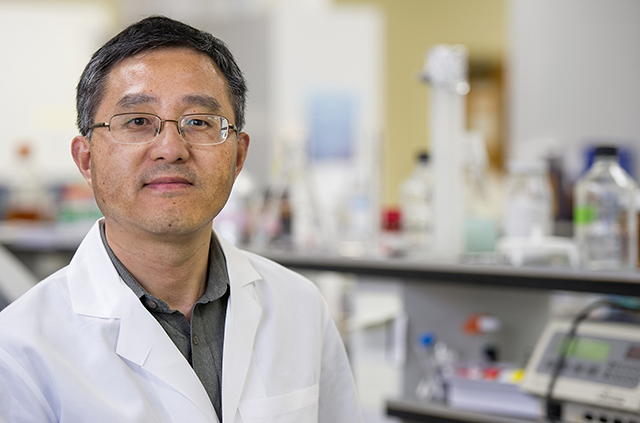Tao brings $1.25 million in funding to research stress and chronic pain

Just what is the role of stress when it comes to healing? What if there were ways to identify, pre-surgery, what patients are most inclined to suffer from chronic pain as a result of their procedure and then to manage that pain?
 Dr. Feng Tao brings these questions and $1.25 million in funding from the National Institute of Dental and Craniofacial Research in his new role as associate professor in biomedical sciences at Texas A&M University Baylor College of Dentistry. Tao had been rooted to Johns Hopkins University in Baltimore since 2000; in May he moved west for the opportunity to apply his research to the dental environment.
Dr. Feng Tao brings these questions and $1.25 million in funding from the National Institute of Dental and Craniofacial Research in his new role as associate professor in biomedical sciences at Texas A&M University Baylor College of Dentistry. Tao had been rooted to Johns Hopkins University in Baltimore since 2000; in May he moved west for the opportunity to apply his research to the dental environment.
With renovations to his fourth-floor now complete, Tao talks about what remains to be discovered about stress and its role in chronic pain, the motivation behind his work and opportunities for synergy with the world-class team of researchers at Texas A&M Baylor College of Dentistry.
Is there a driving force behind the focus of your research? What unknowns do you hope your work will reveal regarding the role of stress in inducing chronic pain?
Pain is a hallmark of tissue damage and inflammation that promotes tissue protection and thereby contributes to repair. Transient acute pain is an important feature of the adaptive response to damage, however, pain can persist for months to years after surgery even though the surgical incision that originally caused the pain has recovered. Such chronic neuropathic pain is maladaptive because it no longer serves as a protective reaction. Chronic pain, especially chronic neuropathic pain, is debilitating, both physiologically and psychologically, and treatments to provide relief from chronic pain are often ineffective. To date, the neurobiological mechanisms that underlie the transition from adaptive acute pain to maladaptive chronic pain are not fully understood. The transition from acute pain to chronic pain is a complex and poorly understood developmental process that involves biological, psychological, and socio-environmental factors.
In our ongoing project, we will demonstrate the molecular mechanism by which stress induces pain transition after surgery. Our data will help physicians predict which patients are at greater risk for developing chronic pain after surgical procedures. Eventually, monitoring of stress hormone levels in the blood may improve pain management in high-risk patients.
Today’s fast-paced world contains more conveniences — and perhaps more stressors — than ever before. Because stress can affect the body’s ability to heal after surgical procedures and medical treatments, an environment that causes constant tension becomes a very real concern. What do we know at this point about stress and its role in causing acute, adaptive pain to transition into chronic, maladaptive pain?
Previous studies have demonstrated that exposure to stressful events induces the release of stress hormones. These stress hormones can regulate glutamate receptor-mediated cellular communication in the central nervous system, including regulating activities of AMPA (α-amino-3-hydroxy-5-methyl-4-isoxazolepropionic acid) receptor (one type of glutamate receptor that mediates fast communication between neural cells). In short, stress hormones affect synaptic trafficking and phosphorylation of AMPA receptors in the central nervous system. The effect of these events is the buildup of pain in the brain in response to peripheral stimulation in the body. In our study, we found that stress significantly impacts the function and activity of AMPA receptors, resulting in prolonged, incision-induced pain. We also found that targeted mutation of AMPA receptors significantly inhibits stress-produced incisional pain prolongation.
After 14 years at Johns Hopkins University, you decided to make the switch to Texas A&M Baylor College of Dentistry. What resources and people made the dental school an attractive option? How do you envision synergy with other researchers here at at the dental school?
My current R01 grant is funded by the National Institute of Dental and Craniofacial Research. Besides the stress-induced pain transition project, I am also interested in dissecting neural circuits related to orofacial pain transmission by using optogenetic manipulation and multichannel electrophysiological recording.
The Department of Biomedical Sciences and the Center for Craniofacial Research and Diagnosis at Texas A&M Baylor College of Dentistry is a perfect platform to conduct such research. Drs. Phillip Kramer and Larry Bellinger in our department are senior investigators who have studied orofacial pain for many years. We have complementary expertise in pain research, and our laboratories are fully equipped for different experimental requirements.
Recently, I wrote a research proposal, and they provided their critical comments. In this proposal, we will use combined optical neuromodulation and large-scale neuronal recording to investigate nociceptive signaling with high spatiotemporal resolution. The overall goal of this project is to unravel nociception-related neural circuits by using above-mentioned cutting-edge techniques. I believe that we can develop a new research project in the near future.
This story originally appeared in TAMBCD’s NewsStand.
Media contact: media@tamu.edu


